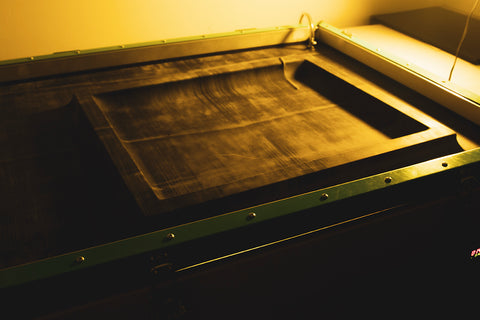Thinking about getting a new exposure unit, or are you ready to upgrade your current unit? Many different kinds of exposure units exist, but let's look into one angle — compression and vacuum exposure units. We'll decipher the differences between the two, how to determine which one is best for you, and other darkroom details.
WHAT IS A VACUUM EXPOSURE UNIT?
The purpose of the vacuum is to create the best, tightest positive contact between the light source, glass, film, and emulsion. Having tight, strong contact to the point where the black ink in the film is almost embedded into the emulsion means that light cannot wrap around the film positive very well. The end result — a straight, clean burn with sharp edges. Vacuum units provide the best detail resolution.
Pro Tip: Bulbs also play a huge factor on exposure results. Check out this article to learn more on that topic.

Photo by Aerogant Printing Co.
WHAT IS A COMPRESSION EXPOSURE UNIT?
Compression exposure units require a bit more work. To replicate the downforce of a vacuum unit, you'll need to put weight on top of the lid or foam to put compression onto the film, screen, emulsion, etc. in order to create the tightest contact possible. Compression exposure units will not achieve the same level of positive contact as vacuum units, but they still do a good job. Edges may be a little rough from time to time, but the stencil will still rinse out well and produce a nice, acceptable print. Depending upon your unit and details of what you're printing, it may be best to use emulsions with diazo such as Baselayr Long Lasting Emulsion or Chromaline CP Tex Water-Resistant Photopolymer Emulsion. The diazo is a resolution and detail enhancer, it helps sharpen edges and is a more forgiving emulsion for smaller exposure units.

Photo by Symmetree Clothing.
THE TYPE OF ART YOU PRINT AFFECTS WHICH UNIT YOU NEED
Halftones, CMYK, sim process, and highly detailed prints will need a vacuum exposure unit. To capture those tiny, tiny details, you require the most tight positive contact between the film and the screen. The vacuum will achieve the best results for these kinds of prints.
Compression exposure units are best for spot color prints like block text. If you want to produce a print with a bit more detail, make sure to use diazo-mixed emulsion.
RELATED: PHOTOSHOP FOR SCREEN PRINTING: ADVANCED COLOR SEPARATIONS
YOUR BUDGET
A huge factor in deciding which unit would be best for you is your budget. As you could imagine, vacuum exposure units are more expensive than compression exposure units. If you'd like to get a vacuum unit but don't have the funds for it right now, buy the cheapest exposure unit you can get away with so you can save money to buy better unit later.
CHECK OUT THE FULL LINE OF EXPOSURE UNITS ON SALE NOW THROUGH MARCH 10th 2024!

Photo by Symmetree Clothing.
YOUR DARKROOM MATTERS
In the end, it doesn't matter if you have a vacuum or compression exposure unit if your darkroom does not have the optimal environment. The darkroom needs to be as dry as possible and light safe. If you need some tips for creating the perfect darkroom, here are a bunch of blogs and videos we've covered on the topic:
- How to Reclaim Screens to Get the Best Results
- How to Dry Reclaimed Screens and Build a Drying Cabinet
- The Darkroom Process: Film, Emulsion Density, Exposing, and Washout
- A Close Up Look of Emulsion Under a Microscope
- How to Make a Better Screen
- How to Dial In Exposure Times Using An Exposure Calculator
- Going Over the Basics: Coating and Exposing Screens

